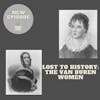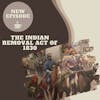Lost to History: The Van Buren Women

Hannah Van Buren never lived to see her husband take the oath of office as the eighth president of the United States. Passing away decades before he hit the national stage, very little is known about the woman who would have become the first First Lady to be born a United States citizen.
Instead, Van Buren came to rely on his daughter in-law, Angelica Singleton Van Buren.
Both of these women played important roles in Van Buren's life, however very little is known about either of them.
Tune in this week as I cover both Hannah Van Buren and Angelica Singleton Van Buren. Who were they? And why don't we know more?
SOURCES:
“Angelica Van Buren.” White House Historical Association. (LINK)
Black, Allida. The First Ladies of the United States of America. “Hannah Van Buren.” White House Historical Association. (LINK)
Cain, Rosie. “White House Hostesses: The Forgotten First Ladies.” White House Historical Association. (LINK)
Costello, Matthew. “The Origins of the American “First Lady.” White House Historical Association. (LINK)
“First Lady Biography: Hannah Van Buren.” National First Ladies’ Library. (LINK)
“Hannah Van Buren.” First Ladies. C-SPAN. (LINK)
“Hannah Van Buren.” History.com Editors. History. Aug 21, 2018. (LINK)
Welcome to Civics and Coffee. My name is Alycia and I am a self-professed history nerd. Each week, I am going to chat about a topic on U.S history and give you both the highlights and occasionally break down some of the complexities in history; and share stories you may not remember learning in high school. All in the time it takes to enjoy a cup of coffee.
INTRO MUSIC
Hey everyone, welcome back.
If you’ve been a long time listener of the show, then you’ve likely picked up on a practice of mine whenever I dive into the histories of the presidential administrations. I also like to cover the women in their lives. I do this for several reasons; one, while there are literally millions of pages dedicated to the men who have occupied the office of president, the same can not be said for the women who held a less official, understated role.
Secondly, I find their stories compelling and fascinating. From Abigail Adams’ counsel to her husband to the social norms started by Dolley Madison, each of these women portray a complex and nuanced view into the inner workings of a political marriage. Lastly, I find that the best way to get people interested in history is to talk about things they connect with. While many are intrigued by the presidential administrations, just as many are interested in the women who proverbially stood behind the man.
Unfortunately what happens much too often is these women - who were prominent and sometimes well known and influential during their lifetimes - get lost to history. There are a number of reasons for this, as I have discussed in prior episodes. And it happens even with women you wouldn’t expect - such as First Lady Elizabeth Monroe.
Well, my friends, I came across another First Lady where the details about her life are scarce and murky. Hannah Van Buren, married to the eighth president, died decades before her husband’s ascension to the presidency. As such, her story is limited and incomplete. Not only because of her early death at the age of 35, but because after her death, Martin Van Buren never spoke of her again.
Given there is so little available on Mrs. Van Buren, I decided to approach this episode a little differently than usual. I will share the life of Hannah Van Buren as best as I can, but will also discuss the woman who served as the White House Hostess during Van Buren’s administration, his daughter in law, Angelica Singleton Van Buren.
So who were these two women? How did the become Van Buren’s? And why are they missing from history?
Grab your cup of coffee, peeps. Let’s do this.
Before I begin with both of these ladies I want to put up a disclaimer that because there was little records of either of these women, my source material is not as robust as I usually strive for. There are no comprehensive biographies dedicated to either lady and any contemporary letters are locked away in university libraries. As such, I am sharing the best from what I could glean from my searches online. Whenever possible, I did try to confirm information in various spaces and relied on sources such as the White House Historical Society for a bulk of the information I am going to share. Without further ado, let’s dive into the first lady of this episode, Hannah Van Buren.
Born in upstate New York on March 8, 1783, Hannah Goes was one of four children born to her parents Maria Quakenbush and Johannes Dircksen Hoes. Like her husband, of whom she was a first cousin, Hannah’s first language was Dutch. She eventually learned English, but never quite shed her accent. And for any of you who may have cringed upon my mentioning Martin and Hannah were cousins, know this was not a overly uncommon practice and was heavily practiced in the Van Buren family, who were concerned about losing their ancestry and had for generations sought out interfamilial marriages.
Popular rumor is that Martin and Hannah were smitten with each other from a young age, but that Martin was committed to setting himself up to properly care for a family before he would consider marriage. So Hannah waited patiently as Martin went off to complete a legal apprenticeship and then set up a law firm with his half brother. Once he felt like he had settled and was in a position to provide, Martin and Hannah were married. The ceremony took place at Hannah’s sister’s home in Catskill, New York on February 21, 1807.
Hannah gave birth to six children during their twelve year marriage, four of which - all sons - lived to adulthood. As I mentioned in my episode on Martin’s career, he was heavily involved in politics from a young age and held a number of political posts before hitting the national stage. In each new assignment, Hannah and the family would join Martin, picking up stakes and moving to set up in his current place of work. Given the costs associated with moving during this time period, many politicians opted to live on their own and keep their families at home. So it speaks to the bond they shared that Van Buren was willing to take on the expense of moving Hannah and the family with him.
Hannah was an active member of the church community and heavily involved in their charitable efforts, even making a request on her death bed to use the money that would normally go towards purchasing scarves for her pallbearers be used to buy food for the poor instead. One contemporary apparently described her as a quote: “woman of sweet nature but few intellectual gifts,” end quote.
It was during her stay in Albany when Van Buren was serving as the state’s Attorney General that Hannah became ill with Tuberculosis. It sucked her energy and ability to perform household chores, which led her to call upon her niece Christina Cantine to come to the house and help care for her young sons. Though weak and unable to stand for very long as a result of the respiratory effects of the disease, Hannah became pregnant and gave birth a final time in 1817.
Hannah never truly recovered from the birth and continued to waist away until she passed on February 5th, 1819 - just two weeks shy of her and Martin’s twelfth wedding anniversary. I am inferring here, but I believe Martin Van Buren was perhaps as bereft as Andrew Jackson at the loss of his beloved. Like Jackson, he never remarried and completely shut himself off from that part of his life. He never spoke of her again, including in his eight hundred page memoirs. He also denied his children information about their mother, with one son needing to confirm her name when he had his own daughter whom he wished to name after his mother.
As Van Buren did not take the oath of office until March 1837, Hannah never got to see her husband strive for the office of president or witness his cabinet tenure during Jackson’s administration. Had she lived long enough to join her husband at the White House, she would have been the first first lady to have been born a United States Citizen.
Unfortunately, that brief summary is the best I could locate on Mrs. Hannah Van Buren. So who was the woman who served as Van Buren’s White House Hostess? Let’s dive in.
Upon moving into the white house, the widowed president brought his four bachelor sons with him. Though Hannah had given birth to a little girl, she did not survive into adulthood and therefore there were no women in the immediate family who could take on the role as hostess. Van Buren’s oldest son Abraham was serving as his father’s private secretary when he met the woman who would steal his heart, and who would step into the White House hostess role.
Angelica Singleton entered the world on February 14, 1816. She was one of six children born to her parents Richard Singleton and Rebecca Travis Coles. Her father, born in the midst of the American Revolution, earned his money by being a planter, specializing in peanuts and cotton and dabbling in a bit of horse breeding as he become interested in horse racing. Unlike most parents of the time, Angelica’s family felt she should receive a robust education, more than what was normally presented to women during this time. In addition to things like dancing and sewing, Angelica learned additional languages and literature while attending first the Columbia Female Academy and then the boarding school in Philadelphia, Madame Greland’s Seminary for Young Ladies.
Attendance at the boarding school was a sign of elite status as tuition was very expensive and enjoyed an prestigious student body such as the granddaughters of the first first lady Martha Washington and future presidential daughter Maria Monroe. The boarding school was considered an immersion school of sorts, with French being the focus. It was here that Angelica likely mastered the French language and got a sense of the European model. Her education stayed with her throughout her life, as she maintained a small collection of books - both literature and science texts.
Upon completing her education, Angelica made her societal debut during the 1836-1837 social season. It was during this introduction to society that Angelica visiting her cousin William Campbell Preston in Washington, DC. During this visit she also made a call on the notorious lady of DC, Dolley Madison. Related to the former first lady through her mother, Angelica enjoyed the social connections provided by Mrs. Madison, including an invitation to a private dinner at the Van Buren White House in March of 1838. In attendance was Van Buren’s eldest son Abraham who became immediately smitten with the young Angelica. Though they’d only just met, Abraham proposed marriage and the two were wed in November the same year.
Van Buren was supportive of the marriage, perhaps hoping for a bump in support for his presidency with a southern daughter in law. However, presidential duties prevented him from attending his son’s wedding and shortly thereafter, Angelica was placed in charge of the social events of the White House. Their marriage seemed perfectly timed for Angelica to take the reins as the social season was just beginning as Angelica and her new husband made their residence at the White House.
Serving as the White House Hostess, Angelica initially relied on the advice and guidance of famed hostess with the mostest, Dolley Madison. Madison’s advice seemed to be effective, as Angelica won rave reviews in her abilities as hostess, with one newspaper observing Angelica was quote, “represented as being a lady of rare accomplishments, very modest, yet perfectly easy and graceful in her manners, and free and vivacious in her conversation,” end quote.
Shortly after their marriage, Abraham and Angelica took a honeymoon in Europe. Watching the official movements of the royal courts sparked something within Angelica. She enjoyed the official receptions, the formal method of receiving guests and adopted this model of receiving court upon her return to the United States. If you remember from past episodes, another first lady tried this to much chagrin from the Washington elite - Mrs. Elizabeth Monroe.
Like Monroe, many Americans bristled at Angelica’s attempts to mirror the official court proceedings she witnessed in Europe. Though Angelica received rave reviews from European visitors, Americans felt her approach was a bit stilted. Her social season didn’t last very long, however, as she was pregnant. During this time period, women who were with child were relegated to private spaces and did not make regular public appearances.
Angelica gave birth to a daughter, named Rebecca after her mother, on March 27th, 1840. Unfortunately, the little girl did not live long - although the sources are conflicting in terms of the little girl’s life. Some mention she survived only a matter of hours, while others indicate she lived several days. Either way, the infant quickly died, leaving a likely bereft Angelica and Abraham. By the time Angelica may have been ready to rejoin the social scene and resume her duties as White House Hostess, Van Buren had already been relegated to a single term in office as William Henry Harrison prepared to take over.
After leaving the White House, Angelica and Abraham moved to New York City and had several more children, suffering another loss, this time a son, in 1843. She was able to journey throughout Europe on extended trips with her family and became interested in charity work. She passed away on December 29, 1878 at the age of 61.
And with that, peeps, we’ve covered the lives of the women of the Van Buren household and administration.
And so why aren’t these ladies more known to history? Well, there are several factors. The role of hostess or first lady is not outlined in the constitution and so the role itself has evolved over the years. This also meant there was no need to capture or otherwise document these women’s experiences as they weren’t dealing in overt matters of state. Another reason is, of course, that as women their papers may not have been preserved as robustly as the more well known men in their lives. This will come up again a few more times as I dive into the first ladies, so please bare with me on those shorter stories.
Be sure to tune in next week as I dive into a listener request and a very october appropriate episode.
If you’ve been enjoying the show so far, please consider a rate and review. Five star ratings help get the show out to the people and make my day. If you ever want me to cover a topic, the inbox is always open.
You can see source material, make episode requests and see transcripts at the website at www dot civics and coffee dot com.
Thanks, peeps. I’ll see you next week.
Thanks for tuning and I hope you enjoyed this episode of Civics & Coffee. If you want to hear more small snippets from american history, be sure to subscribe wherever you get your podcasts. Thanks for listening and I look forward to our next cup of coffee together.
OUTRO MUSIC
Listener Favorites
Not sure where to begin? Take a listen to some fan favorites.

























